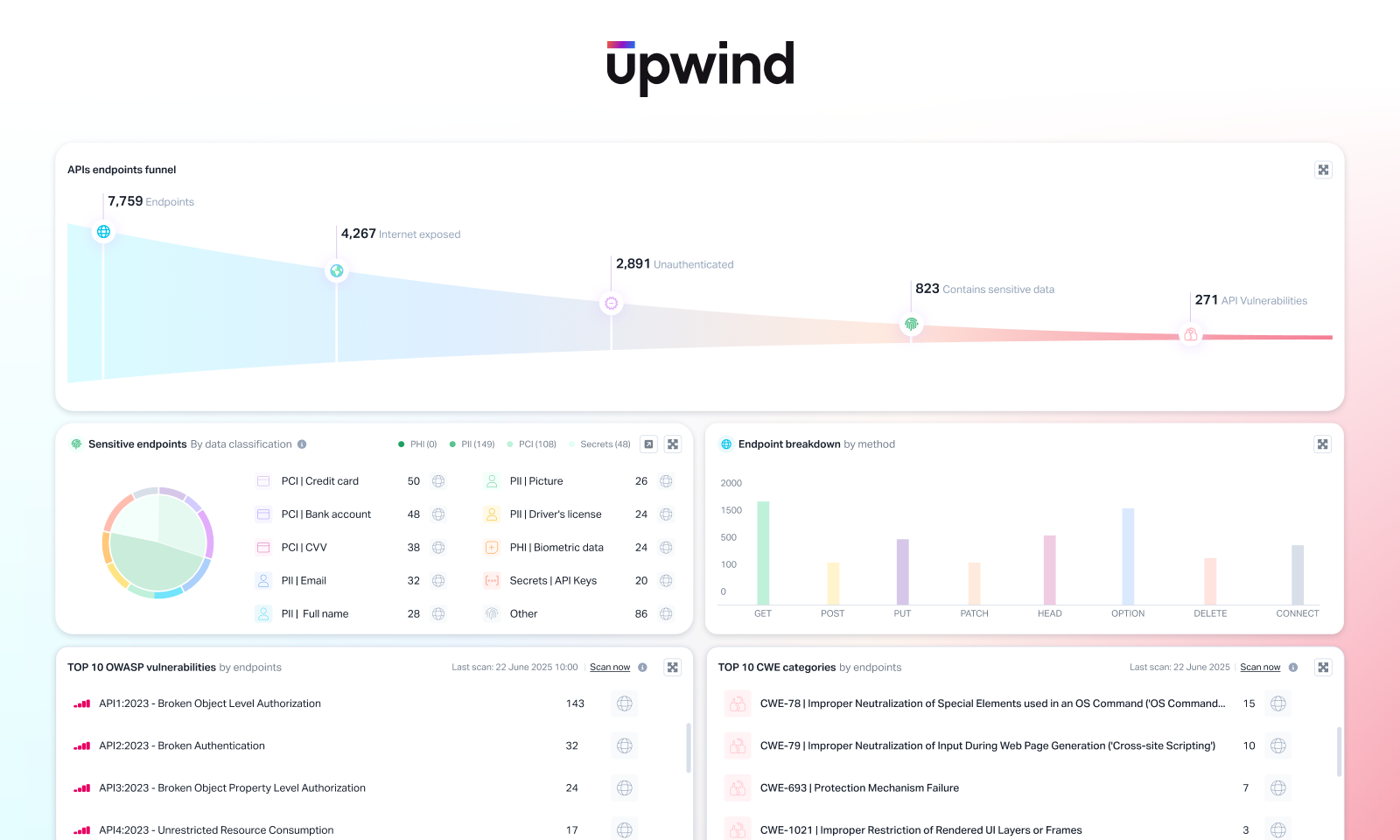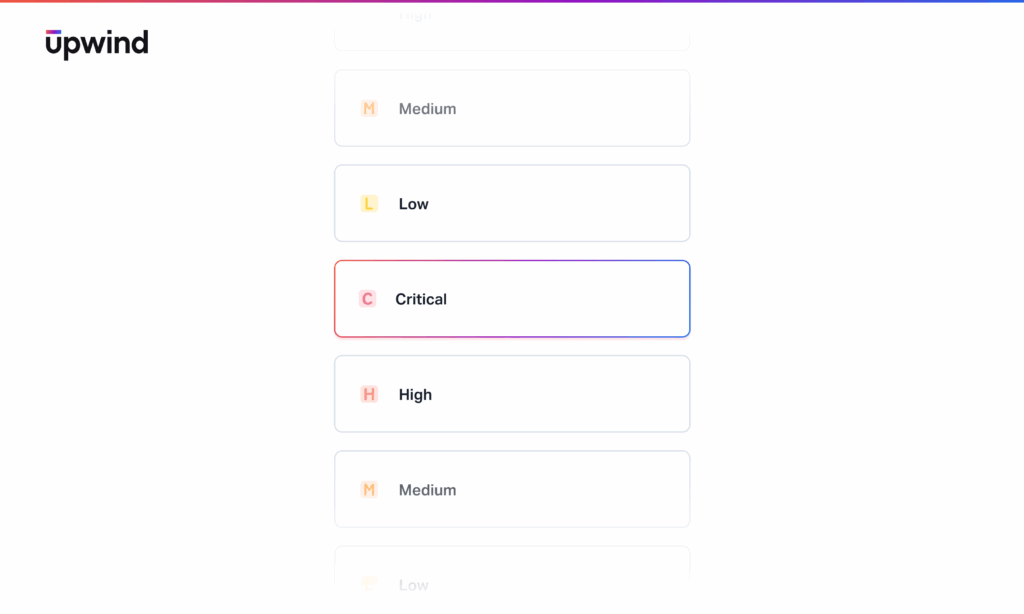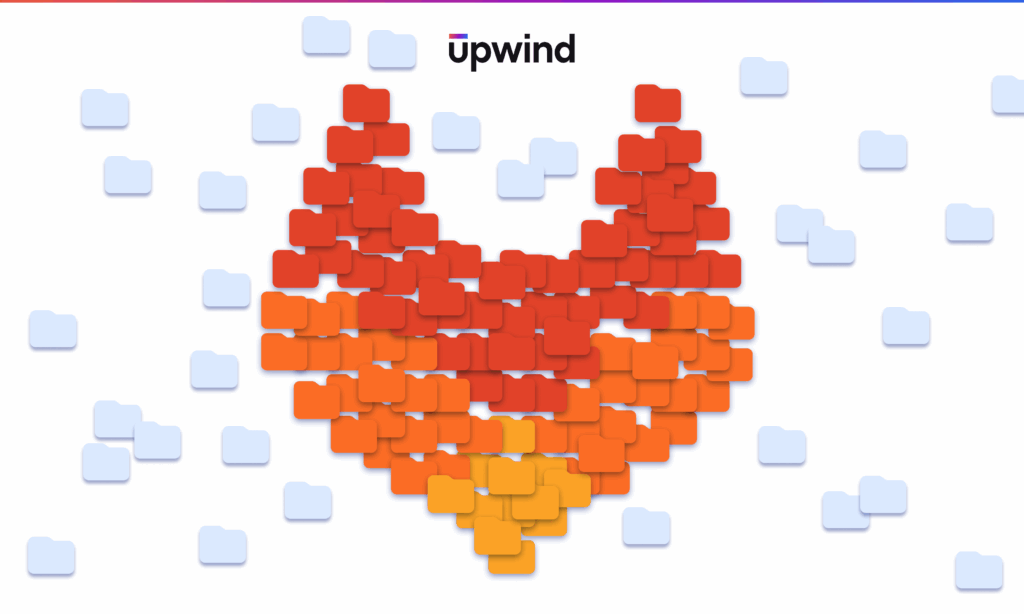
From Discovery to Defense: Upwind’s New API Security Dashboard
At Upwind Security, we’re excited to bring a new kind of CNAPP to life – one that puts APIs and applications at the center of cloud defense. APIs have become the backbone of modern cloud-native architectures, yet they remain one of the most overlooked and exploited entry points. It’s not just a future concern; it’s a present crisis. Gartner projects that through 2025, over 50% of data theft will be attributed to unsecured APIs. VentureBeat reports that API vulnerabilities are already costing businesses a staggering $75 billion each year. These risks demand more than traditional visibility – they require real-time context, prioritization, and action. That’s what Upwind is delivering, and that’s why we built our API Security Dashboard: to help teams uncover, understand, and secure their most critical API exposures before they turn into headlines.
“Wait… That API Was Public?” – Imagine this: A Fortune 500 company discovers during a routine audit that a forgotten internal API is not only still live but also publicly accessible and actively processing unencrypted customer PII. It has been that way for over eight months. No alerts were triggered. No monitoring system flagged it. And despite having dozens of security tools, no one had visibility into this API until it was found manually. There’s no malware, no exploit, no active breach. But the exposure itself? A serious risk that had gone unnoticed..
This kind of scenario is becoming all too common. APIs are dynamic, sprawling, and constantly changing. They are also one of the most overlooked and poorly understood parts of the modern attack surface. Security teams know the risk is there, but they often lack the tools to see it clearly, prioritize it correctly, and act fast enough. That’s we built our new API Security Dashboard: to give security teams the tools to move from visibility into action.
Upwind’s dashboard empowers security teams to swiftly answer crucial questions such as:
- “Where are our APIs exposed?”
- “Which APIs process sensitive data?”
- “Which API vulnerabilities should we prioritize?”
This dashboard is more than a new interface. It represents a more intelligent approach to API risk management, distilling complex API data into clear, prioritized actions and moving from mere visibility to decisive action.
Focus on What Matters Most
Upwind’s API dashboard gives you a unified view of all discovered API endpoints. It pulls everything into one place so you can see the full picture instantly. This view is then refined using various risk criteria, including internet exposure, authentication status, data sensitivity, and known vulnerabilities, significantly reducing investigation time from hours to seconds.
Quickly Understand Sensitive Endpoints
Knowing where your sensitive data is exposed is crucial – and Upwind’s API Dashboard brings that clarity front and center. The sensitive data endpoints overview displays a detailed breakdown of all API endpoints that expose sensitive data, grouped by data classification – including PII (Personally Identifiable Information), PCI (Payment Card Information), secrets, and other confidential types. It also provides a visual distribution of data exposure, helping teams quickly understand the scope and severity of their risk.
This makes it easy to pinpoint high-risk areas, such as unauthenticated endpoints publicly exposing sensitive information – clear indicators of critical vulnerabilities. With this level of visibility, security teams can take proactive steps to mitigate risk before it can be exploited.
Deliver Shared Visibility Across Teams
The API Dashboard also surfaces trends and context that help security and development teams get on the same page. You’ll see a breakdown of HTTP methods in use, mapped OWASP Top 10 vulnerabilities, and CWE categories to highlight the root causes behind your issues. With this shared context, teams can fix vulnerabilities faster, reduce friction, and move beyond reactive patching to more strategic remediation.
Further, the Risky Endpoints view makes prioritization even easier by flagging the endpoints that are not just vulnerable, but also unauthenticated, exposed, and sensitive – giving you a clear, actionable starting point.
Built for Speed: From Onboarding to Insight, Instantly
Getting started with Upwind’s API Security Dashboard is straightforward and efficient. With the new “Scan Now” feature, teams can initiate their first API scan within seconds with no complex configuration or waiting period required. One early user found dozens of unauthenticated endpoints within minutes of setup. This means you can begin uncovering API risks and gaining meaningful insights almost immediately, allowing security teams to start addressing issues from day one.
What You Can Expect Next
We’ve already begun expanding the dashboard to offer drill-down views for every component enabling security teams to go from high-level trends to individual endpoint details with a single click. Soon, you’ll be able to track trends over time and connect findings across environments. You’ll also be able to generate automated reports for auditors, leadership, and compliance – all from within the dashboard.
Our goal is to simplify API security by giving teams real-time clarity, stronger prioritization, and more impact with less manual effort at every step.
What This Means
Upwind’s API Security Dashboard helps security teams see clearly, act quickly, and stay ahead of risk. Instead of flooding you with alerts, it highlights the endpoints that matter most based on exposure, sensitivity, and vulnerability risk.
With Upwind’s new API Dashboard, you gain:
- Real-time visibility into your full API risk landscape.
- Instant insights into exposure, misconfigurations, and trends.
- The ability to prioritize and explain issues to stakeholders.
- A strong foundation for automation and continuous improvement.
Final Thoughts
As APIs grow more complex, security teams need more than just visibility. They need clear, actionable intelligence. Upwind’s API Security Dashboard delivers that, turning fragmented signals into real-time, prioritized insights.
Whether you’re identifying publicly exposed endpoints with PII, fixing known vulnerabilities, or working with developers to secure authentication gaps, the dashboard helps you move faster and focus on what matters most.




